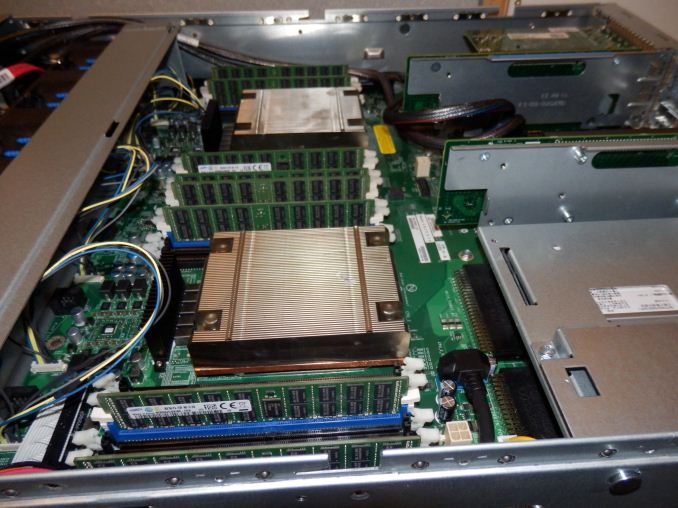Intel Xeon E5 Version 3: Up to 18 Haswell EP Cores
by Johan De Gelas on September 8, 2014 12:30 PM EST
Simply put, the new Intel Xeon "Haswell EP" chips are multi-core behemoths: they support up to eighteen cores (with Hyper-Threading yielding 36 logical cores). Core counts have been increasing for years now, so it is easy to dismiss the new Xeon E5-2600 v3 as "business as usual", but it is definitely not. Piling up cores inside a CPU package is one thing, but getting them to do useful work is a long chain of engineering efforts that starts with hardware intelligence and that ends with making good use of the best software libraries available.
While some sites previously reported that an "unknown source" told them Intel was cooking up a 14-core Haswell EP Xeon chip, and that the next generation 14 nm Xeon E5 "Broadwell" would be an 18-core design, the reality is that Intel has an 18-core Haswell EP design, and we have it for testing. This is yet another example of truth beating fiction.
18 cores and 45MB LLC under that shiny new and larger heatspreader.
The technical challenge of the first step to make sure that such a multi-core monster actually works is the pinnacle of CPU engineering. The biggest challenge is keeping all those cores fed with data. A massive (up to 45MB) L3 cache will help, but with such massive caches, the latency and power consumption can soar quickly. Such high core counts introduce many other problems as well: cache coherency traffic can grow exponentially, one thread can get too far ahead of another, the memory controller can become a bottleneck, and so on. And there is more than the "internal CPU politics".
Servers have evolved into being small datacenters: in a modern virtualized server, some of the storage and network services that used to be handled by external devices are now software inside of virtual machines (VMware vSAN and NSX for example). In other words, not only are these servers the home of many applications, the requirements of these applications are diverging. Some of these applications may hog the Last Level Cache and starve the others, others may impose a heavy toll on the internal I/O. It will be interesting to see how well the extra cores can be turned into real world productivity gains.
The new Xeon E5 is also a challenge to the datacenter manager looking to make new server investments. With 22 new SKUs ranging from a 3.5GHz quad-core model up to an 18-core 2.3GHz SKU, there are almost too many choices. While we don't have all of the SKUs for testing, we do have several of them, so let's dig in and see what Haswell EP has to offer.











85 Comments
View All Comments
bsd228 - Friday, September 12, 2014 - link
Now go price memory for M class Sun servers...even small upgrades are 5 figures and going 4 years back, a mid sized M4000 type server was going to cost you around 100k with moderate amounts of memory.And take up a large portion of the rack. Whereas you can stick two of these 18 core guys in a 1U server and have 10 of them (180 cores) for around the same sort of money.
Big iron still has its place, but the economics will always be lousy.
platinumjsi - Tuesday, September 9, 2014 - link
ASRock are selling boards with DDR3 support, any idea how that works?http://www.asrockrack.com/general/productdetail.as...
TiGr1982 - Tuesday, September 9, 2014 - link
Well... ASRock is generally famous "marrying" different gen hardware.But here, since this is about DDR RAM, governed by the CPU itself (because memory controller is inside the CPU), then my only guess is Xeon E5 v3 may have dual-mode memory controller (supporting either DDR4 or DDR3), similarly as Phenom II had back in 2009-2011, which supported either DDR2 or DDR3, depending on where you plugged it in.
If so, then probably just the performance of E5 v3 with DDR3 may be somewhat inferior in comparison with DDR4.
alpha754293 - Tuesday, September 9, 2014 - link
No LS-DYNA runs? And yes, for HPC applications, you actually CAN have too many cores (because you can't keep the working cores pegged with work/something to do, so you end up with a lot of data migration between cores, which is bad, since moving data means that you're not doing any useful work ON the data).And how you decompose the domain (for both LS-DYNA and CFD makes a HUGE difference on total runtime performance).
JohanAnandtech - Tuesday, September 9, 2014 - link
No, I hope to get that one done in the more Windows/ESXi oriented review.Klimax - Tuesday, September 9, 2014 - link
Nice review. Next stop: Windows Server. (And MS-SQL..)JohanAnandtech - Tuesday, September 9, 2014 - link
Agreed. PCIe Flash and SQL server look like a nice combination to test this new Xeons.TiGr1982 - Tuesday, September 9, 2014 - link
Xeon 5500 series (Nehalem-EP): up to 4 cores (45 nm)Xeon 5600 series (Westmere-EP): up to 6 cores (32 nm)
Xeon E5 v1 (Sandy Bridge-EP): up to 8 cores (32 nm)
Xeon E5 v2 (Ivy Bridge-EP): up to 12 cores (22 nm)
Xeon E5 v3 (Haswell-EP): up to 18 cores (22 nm)
So, in this progression, core count increases by 50% (1.5 times) almost each generation.
So, what's gonna be next:
Xeon E5 v4 (Broadwell-EP): up to 27 cores (14 nm) ?
Maybe four rows with 5 cores and one row with 7 cores (4 x 5 + 7 = 27) ?
wallysb01 - Wednesday, September 10, 2014 - link
My money is on 24 cores.SuperVeloce - Tuesday, September 9, 2014 - link
What's the story with 2637v3? Only 4 cores and the same freqency and $1k price as 6core 2637v2? By far the most pointless cpu on the list.